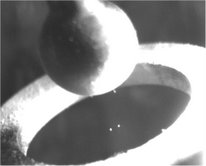Prizes totaling NIS 5000 were awarded to writers of scientific entries on Wikipedia, the free Hebrew encyclopedia

In the last month, dozens of writers participated in the "PhysicWiki" competition, the purpose of which is to expand and improve the values related to scientific issues in the Hebrew Wikipedia, and to attract scientifically oriented writers to it.
The beginning of the competition, with a doctoral student in optics at the Weizmann Institute, Motti Friedman, who wanted to write an entry on Wikipedia. "I saw that there was a lack of entries on the topic of optics and I wanted to write one", Friedman explains, "I wasn't very organized when writing the entry, so I turned to one of the volunteers at Wikipedia, Yoni Toker, who is also a doctoral student at the institute, and in the first conversation with him the idea was to initiate a writing contest that would attract new writers."
The two asked for help and a budget from the head of the institute's physics department, Prof. Gregory Falkovitz, and the dean of the physics faculty, Prof. Yossi Nir. The answer of the two was the same: our children use Wikipedia all the time and we see it as an important tool and see the competition as an excellent idea, and they agreed to provide a budget for the competition.
"What's beautiful about the contest is that it's not a one-off and doesn't end with the 20 entries written," Friedman concludes, "Wikipedia has now gained 20 new writers, who will surely continue to contribute beyond the contest. In any case, we intend to hold the competition next year as well."
The competition was organized by the Wikimedia Israel Association, the Department of Physics of Complex Systems at the Weizmann Institute of Science, the Davidson Institute and the OSA Association.
Here are the winners of the competition:
• First place: the optical communication entry written by the user "Abgada", will win its author a prize of NIS 2500.
• Second place: the optical forceps entry written by the user Gershon Avi, will win its writer a prize of 1500 NIS.
• And in third place: the entry Galvo, written by Yitzhak Baum, a prize of 1000 NIS.
The judges in the contest praised the entry "Gaussian Kern" (written by the user "Mathknight"), the photo "Paul's Trap" taken by Tali Vakanin and the illustrations contributed by the user "Deltafunction". Donors were awarded gift packages.

3 תגובות
I didn't understand, how do you find the person who wrote the entry? (for example "Abgada" who won first place) and how does he prove that it is him and not someone else? After all, the writing there is anonymous, how exactly does that work out?
One who studied:
I assume the wikipedia you used was the English one.
The Israeli one has been under criticism for many years (in my opinion because of a takeover by foreign interests) and I hope that the current activity will change the situation.
It's unbelievable how Wikipedia has taken over the world of physics... :-)
Throughout my first degree I used Wikipedia and in the master's exam one of the examiners presented a certain fact and at the end said "this is how it appears on Wikipedia".
When this happens then you know that it is an integral part of the world of physics.
I imagine this happens in other sciences but I haven't really checked.
In any case, it's very, very convenient, if you forget something, just open Wikipedia and it's there with the formulas and everything.